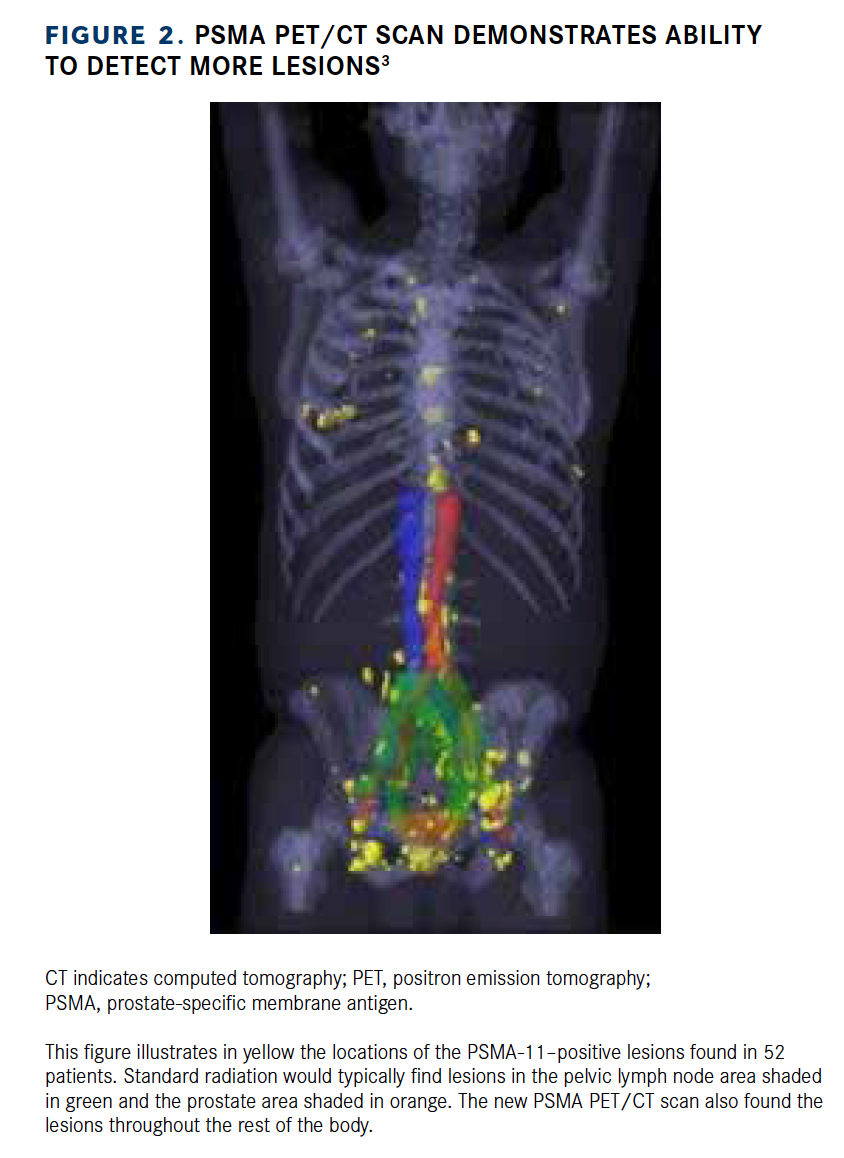Publication
Article
Novel Imaging Method Proves Effective in Detecting Prostate Cancer Recurrence
Author(s):
In a recent study, investigators at UCLA and UCSF have demonstrated high positive predictive value for a new imaging technique for localizing recurrent prostate cancer.

Jeremie Calais, MD, MSc
Assistant Professor
of Nuclear Medicine
and Theranostics,
David Geffen School
of Medicine, University of
California, Los Angeles
In a recent study, investigators at the University of California in Los Angeles (UCLA) and San Francisco (UCSF) have demonstrated high positive predictive value for a new imaging technique for localizing recurrent prostate cancer.1 The diagnostic test is called prostatespecific membrane antigen positron emission tomography/ computed tomography imaging, or PSMA PET/CT, and is used to help treat patients who have previously had radiation or surgery for prostate cancer. The study’s results demonstrated that this scan is effective in finding the location of a recurrence of prostate cancer cells (Figure 1).1
Imaging is important for men who have been treated for prostate cancer because sometimes cancer cells remain in the body after surgery. This happens if not all cancer cells are removed during the surgical procedure or if some of the tumors lie beyond the prostate region. Determining the recurrent tumor locations can help for a better individualized treatment approach.
It is important for patients with signs of recurrence after initial therapy to undergo an imaging scan to find the location of the cancer cells.
To examine the effectiveness of the new imaging technique, investigators at the UCLA Jonsson Comprehensive Cancer Center and UCSF collaborated on a multicenter study to evaluate imaging with 68GA-PSMA-11, a PET scan with a gallium-labeled PSMA ligand. The team, which published its findings in JAMA Oncology, included Johannes Czernin, MD, and Wolfgang P. Fendler, MD, both of UCLA, and Thomas A. Hope, MD, of the UCSF.1
The scan was performed on 635 patients previously treated with prostatectomy, radiation therapy, or both. Participants had a proven biochemical recurrence of cancer, defined as a prostate-specific antigen (PSA) level ≥0.2 ng/mL more than 6 weeks after prostatectomy or a PSA of ≥2 rise above nadir following radiation therapy.
The novel diagnostic test was able to detect cancer cells in 475 patients (75%) with a positive predictive value of 84% to 92%.1
PSMA PET/CT Versus Standard of Care
In a follow-up study, the UCLA team of investigators independently continued the evaluation of the PSMA PET/CT scan. Calais and colleagues, including Czernin, published findings in Lancet showing PSMA PET/CT to be more effective in finding an early recurrence of prostate cancer after surgery compared with the current standard-of-care technique, 18F-fluciclovine PET/CT.2
Fluciclovine is a synthetic amino acid used as a radiotracer. Cancer cells consume more amino acids than regular cells, and this imaging technique enables doctors to identify the location of the cancer by tracking the cells that consume more of the fluciclovine.
By contrast, the PSMA imaging technique tracks protein expression levels. Prostate cancer cells overexpress PSMA in comparison with normal cells, and this imaging method can determine the location of the cancer cells by tracking these cell-surface proteins.
Click to Enlarge

Click to Enlarge

For the purposes of the study, investigators deidentified the scan images. These images were sent to 3 independent physician readers, each of whom read the scans 3 times. Individual readers were unaware of the conclusions reached by the others.
The results showed that the PSMA imaging was able to detect the recurrence of prostate cancer in 56% of the scans. In comparison, the fluciclovine scan was able to detect prostate cancer in 26% of the scans (OR, 4.8; 95% CI, 1.6-19.2; P = .0026).
The UCLA investigative team concluded that, because of its effectiveness, PSMA imaging should be the PET imaging agent of choice for men who have prostate cancer recurrence after radical prostatectomy. The PSMA PET/CT scan continues to be investigated, beyond the clinical trials described previously.
PSMA PET/CT May Improve Radiation Therapy Outcomes
PSMA PET/CT also may have a significant role in guiding salvage radiation therapy for patients who have undergone radical prostatectomy, according to findings that Calais and colleagues, inclduing Nicholas G. Nickols, MD, PhD, of UCLA, published in the Journal of Nuclear Medicine (Figure 2).3
In June 2019, the editors of the publication cited the study as one of the best articles published by the journal in 2018. It won the Editor’s Choice Award for Best Clinical Article and was named Overall Best Article in 2018. The article has been cited more than 95 times by other study authors and provided the rationale to initiate a phase III randomized trial powered for outcome.4
Beyond Prostate Cancer
Beyond prostate cancer, the UCLA investigative team is testing the PSMA PET/CT imaging technique to detect the vasculature cells of multiple cancers such as pancreatic, ovarian, head and neck, lung, and breast. This is because the PSMA chemical compound binds to proteins found on the surface of vasculature cells and can be seen through nuclear imaging. In this study, patients will also undergo fibroblast activation protein inhibitor PET/CT, which can show the stromal cells surrounding the tumor lesions. Breaking up stroma and blood vessels necessary for cancer growth, may make tumors easier to treat with medication, radiation, and cell-based immunotherapy.
References
- Fendler WP, Calais J, Eiber M, et al. Assessment of 68Ga-PSMA-11 PET accuracy in localizing recurrent prostate cancer: a prospective single-arm clinical trial. JAMA Oncol. 2019;5(6):856-863. doi: 10.1001/jamaoncol.2019.0096.
- Calais J, Ceci F, Eiber M, et al. 18F-fluciclovine PET-CT and 68Ga-PSMA-11 PET-CT in patients with early biochemical recurrence after prostatectomy: a prospective, single-centre, single-arm, comparative imaging trial. Lancet. 2019;20(9):1286-1294. doi: 10.1016/S1470-2045(19)30415-2.
- Calais J, Czernin J, Cao M, et al. 68Ga-PSMA-11 PET/CT Mapping of prostate cancer biochemical recurrence after radical prostatectomy in 270 patients with a PSA level of less than 1.0 ng/ml: impact on salvage radiotherapy planning. J Nucl Med. 2018;59(2):230-237. doi: 10.2967/jnumed.117.201749.
- Best JNM articles for 2018. J Nucl Med. 2019;60(6):16N. Journal of Nuclear Medicine. jnm.snmjournals.org/content/60/6/16N.full.pdf+html. Accessed February 25, 2020.
The men each received a fluciclovine scan as part of their postsurgical recurrence standard-of-care treatment. They also received an additional PSMA imaging scan within 15 days before or after their fluciclovine scan.
In comparing these 2 imaging methods, UCLA researchers studied 50 patients. Each of the patients had previously undergone a radical prostatectomy in which surgeons removed the prostate gland and surrounding tissue due to cancer. Enrollment criteria included biochemical recurrence of prostate cancer with low PSA levels (<2.0 ng/mL) indicating that cancer recurrence was at an early stage.










